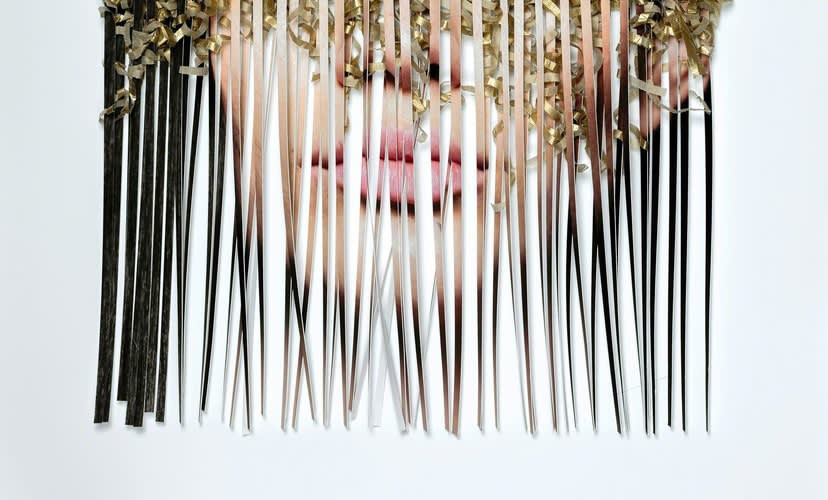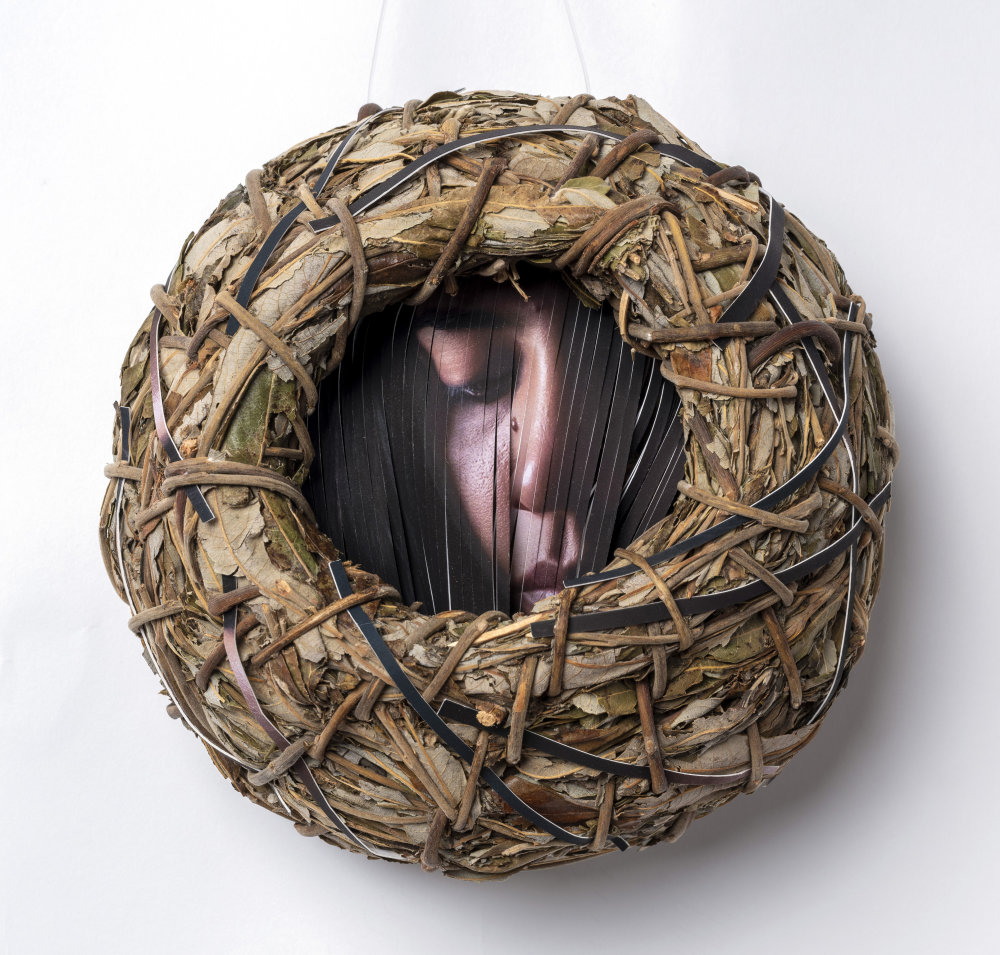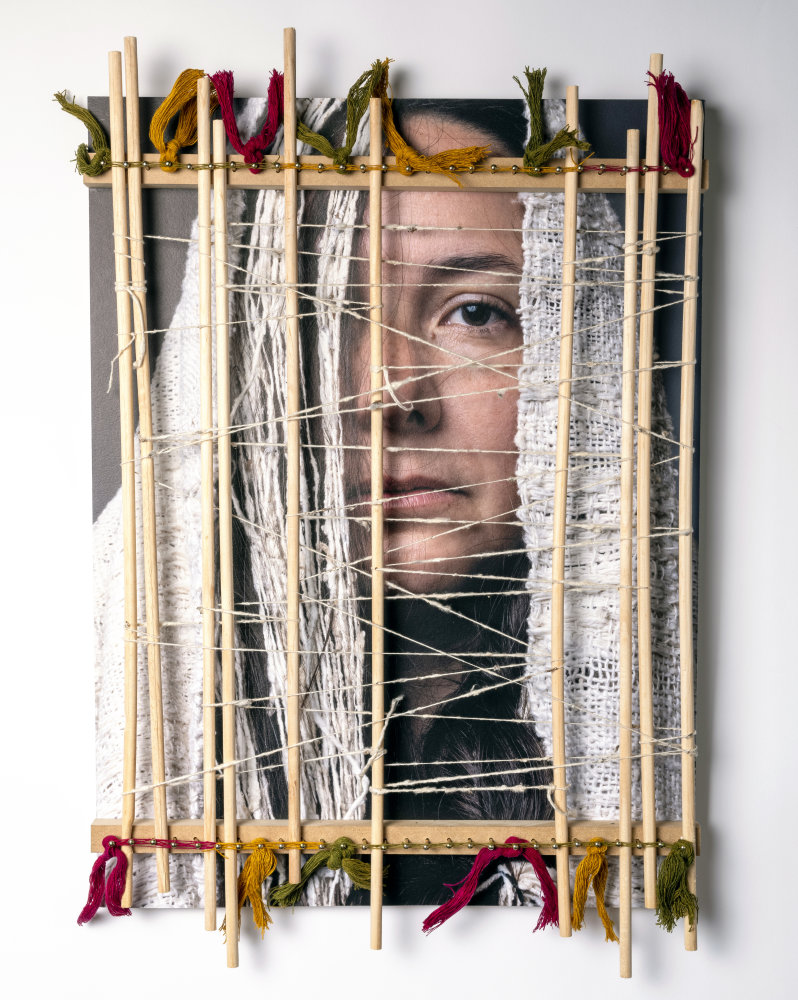
Lou Peralta’s portraiture project “Disassemble” seeks out people from different regions of Mexico that reflect the country’s varied cultural heritage and celebrates the diverse genetic make-up of their physical characteristics. Peralta seeks to build appreciation for a new Mexican identity and overcome certain stereotypes and preconceptions. The images are embedded, sewn, and woven with materials that Peralta says are the “DNA” of Mexican life from the regions that the people photographed call home. She feels her images will create a new energy and consciousness regarding what it means to be Mexican.
To disassemble means to take something apart. In a sense, Peralta’s portraits are visually abstracted by cutting, bending and sectioning the faces. The viewer must gaze into the image to see the individual and study the characteristics that make the subject uniquely identifiable. Peralta is not interested in her subject’s present state; rather, she is interested in dissecting their image and examining their past to redefine our future impressions. In a sense, Peralta wants us to look at parts of the person, and, like a puzzle, reassemble them. As the viewer reassembles the face, they must think about what they see in that person. In doing this, the viewer must challenge assumptions, bias and preconceived notions about that person. What gives them a certain “look”? What assumptions would we make about where they come from? (Peralta’s “Disassemble” Series I, II and III can be studied on her website at https://www.louperalta.art/lou-peralta-©—disassemble-iii.html.) It is this act of disassembly that brings us together and unifies us, in a sense, as we seek familiarity and common ground with the fractured image of what we know to be the face of a fellow human being.
Peralta does not overcome stereotypes and preconceptions by identifying them. She takes a positive path, as an artist, to show us what is within the people of Mexico she photographs. “I was thinking … that Mexico is a very rich country in tradition and culture that probably is not known all over the world. Even though my prime intention is to talk about that a portrait is much more than the capture of the physical characteristics of a person, but the capture of an internal consciousness and cultural heritage. I wish through my compatriots that I had the opportunity to photograph for this series, to show a bit of my vision of who we are and some of the elements and textures I love from my land. Almost every region in Mexico has its own heritage of indigenous language and culture, its own gastronomy, biodiversity and climate. However, this is not intended to be a proportional demographical description of Mexico…”
Lou Peralta grew up in a family of photographers with a 100 year old set of traditions in portraiture. She is the fourth generation to use camera and light to create a visual record and story through portraiture. She has years of experience examining faces in an effort to bring the “inner” person to the surface for the camera to capture in a singular moment, as exemplified in her own words: “For me a portrait is an attempt to capture a spark of that energy of someone’s personality. Sometimes, depending on the day, … you come to see the bright or dark side of their personality. This is also an exploration of the complexity of a human being. … our face… it’s never static … we are constantly moving, our state of mind shifting and evolving…”
While there is artistry in her traditional portraiture work, “Disassemble” is Peralta’s first effort at expression as a contemporary artist that transcends an individual and speaks about a nation. The artist herself is Mexican, explaining how “I am Mexican, a descendant of Indians of cultures from the pre-Columbian era (before Christopher Columbus): Teotihuacan, Aztec, Mayan, etc., but also of Europeans, mostly Spaniards. …we are, on the most part, “mestizos”, (mixture between Europeans (Spaniards) and indigenous people), there is also a large group of indigenous population and also a small group of Afro-Mexicans too, among people from other countries that have established here.” Peralta’s images are pieces of a puzzle that, when put together, speak to the diversity and essence that is Mexico.
A special engagement is created from turning a portrait into a cultural object of art. The materials woven into each image represent centuries of cultural heritage. In some cases, the materials are from her own “ancestors”, in a sense, imbuing her own legacy in that work. The faces are deconstructed, reconstructed, and “impregnated with the essence of heritage and inner essence of the person.” The objects used might include feathers from her grandmother’s hat, silk, parts of an old necklace, fragments of a woven shawl, rug or wool dyed with cochineal or pomegranate. These assemblages become both a mirror of today and a window into a rich past for the 32 states that comprise Mexico today. Each piece is uniquely hand made, and different in content and style.
Peralta’s on-going project looks to these states to help define different autochthonous (of an inhabitant of a place, an indigenous people rather than descended from migrants or colonists) people. She recognizes that most Mexicans today have a mixed heritage. But, people from these different states can help a viewer sense that state’s distinctive heritage. “We can say I have portrayed people of nine (9) states of Mexico. I cannot say they represent each state because there are several groups of people in each state. For now, I can only say I portrayed people from these few states in Mexico at this stage of my work. Those location are indicated on the map…” Within the images created, she has photographed people from Chihuahua, Guerrero, Mexico City, Michoacán, Morelos, Oaxaca, Sinaloa, Veracruz, and Yucatán.
The history of photography is rich in precedent and inspiration for Peralta’s effort to define a people or group of people within a society or ethnic or socio-economic group. Within the photographic history of Mexico are many well-known photographers who captured the spirit of the Mexican people. These artists include Manuel Álvarez Bravo, Pedro Meyer, Graciela Iturbide, Romualdo García, Flor Garduño and photojournalist Augustín Víctor Casasola. Additional Latin American artists working in the same vein include Guatemalan Luis González Palma, who also focused his efforts on “mestizo” mixed-race people, and Peruvian Martín Chambi Jiménez who photographed his country’s indigenous people. More contemporary photographers that influence Peralta include Dorian Ulises López Macías, whose work reinforces an appreciation for a Mexican beauty norm independent from “euro-centric ideals,” and Diego Huerta, another young photographer based in Austin, Texas, who creates portraits and stories of people in Mexico using both video and still images. Some of Huerta’s work involves straight portraiture of young people randomly encountered on the street. These contemporary photographers, however, demonstrate more traditional portrait and editorial-style portfolios, and are not manipulating their imagery in the same fashion as Peralta.
As a student of photography, Peralta’s work is also influenced by artists outside of Latin America: AugustSander created “Man of the Twentieth Century”, a monumental project to photograph people of all occupations and types in Germany starting in the 1920s and later. Richard Avedon photographed people of the American West. Roman Vishniac documented Jewish life in eastern Europe, while Lewis Hine documented working and living conditions of children in the United States between 1908 and 1924 for the National Child Labor Committee (NCLC). Diane Arbus sought out deviant and marginal people seen as out casts of society. Each of these other photographers influenced Peralta’s search for her own distinctive portrayal of the Mexican people.
The distinguishing feature of Peralta’s approach is its focus on beauty and the native local culture. The act of showing a Mexican artist at the gallery in the current climate towards immigrants from Latin America may be misunderstood. It is not intended, on her part, to be a political statement to a viewer of the exhibition in or from Mexico. Nor is it intended to be a political statement for an international art patron (e.g. American audience). Peralta commented: “I focused on the importance of the appreciation of the greatness of the human being and its individuality… because I believe that to take a portrait you have to focus on the individuality of each person to try to capture their inner essence, but this has no nationality. …It is an immense joy to share a bit of my culture through my pieces, but it is not my intention to use them to make any political statement.” Peralta’s work is a celebration through art of individuals steeped in a rich & joyous culture that is Mexico. There is an underlying surrealist and expressionist influence, which has been a strong influence in Mexican art. Foto Relevance Gallerist Erica Cheung observed that this nod towards the influences of surrealism & expressionism in Peralta’s work is seen in the portraits themselves. Cheung commented that the sitters are often quiet and they wear rather subdued expressions, but there is something striking about them regardless and part of the reason these figures are captivating is indeed how their portrait interacts with the physical materials. Peralta’s work is distinguished by her actual physical use of local native materials embedded and woven into these images, as seen in “Disassemble 41”, rather than incorporated into the photograph itself as a prop or costume.

© Lou Peralta, Disassemble #41 (2019)
Peralta’s form of portraiture is sculptural. Her intervention in the images breaks through formality. The added dimension carries us deeper not only into the subjects’ personas, but into a broader cultural sense of a region of Mexico. We traditionally see photography of sculpture, or an inanimate object, rather than photography assculpture. An example would be Henri Cartier-Bresson’s 1932 image “Martigues, France”. By creating a sculptural object, Peralta directs how we will see a portrait differently. Photographing a face and then manipulating the image to accommodate other materials is intriguing but also disquieting. Perhaps it is disquieting partly due to the fact that we are primed to see traditional portraits all the time, so when faced with an alteration to that tradition, we look twice. Combining a face with other objects in a photograph as a montage reaches back to Salvador Dali (1933) and to Man Ray in 1926. A classic image is Man Ray’s “Noire et Blanche (Black & White)”, 1926, with the woman’s face placed next to an elegant mask sculpture. Peter C. Bunnell, curator of photography at the Museum of Modern Art (MoMA) curated the first exhibition of photographically formed images used in a sculptural manner in 1970, entitled “Photography into Sculpture." Several artists today—some that identify as photographers, and some that do not—have created photo-sculptural images, including Jane Szabo’s “Sense of Self” dresses, Hans Breder (and contemporary photographer Loreal Prystaj) used mirrors to entwine the body into the landscape, and works by Michel Le Belhomme such as visually multilayered series “The Two Labyrniths”. However each of these practices still yield a two-dimensional image as the object of art. The sculpture created, in turn, is often lost, destroyed, or put aside.

© Lou Peralta, Disassemble #54 (2019)
With Peralta, however, the works created are physically 3-dimensional sculptures that become the objects of art to embrace. Peralta’s most tactile pieces, as again observed by Cheung, such as the basket (“Disassemble 54”, below), by use of craft materials, turn her photographs—which are pristine portraits on their own—into something more accessible, in the sense that they are not presented as standard print on paper on the wall. In “Disassemble 54”, Peralta inserted a portrait she created into the basket, or nest as it might appear, which was constructed by Craftswoman Eva Salazar, a member of the Kumiai Community of Baja California Norte, according to Peralta. “The basket is made with willow leaves and branches. It is used to collect and store seeds and fruit.” Cheung’s reaction was that: “The work is so wonderfully tactile that it looks like it’s meant to be handled/touched (even though it’s not!).”
What do these images reveal about Mexican culture? To date there are thirty four (34) images in Peralta’s portfolio selected to illustrate what she sees as Mexico today. For one, clearly, diversity. Mexico, as Peralta herself, is united around deep genetic roots from many different indigenous and non-indigenous people. For another, celebration. In “Disassemble 22,” there are the “serpentine” golden strips that are part of Mexican festivals. Mexico is a country of many colors and known for its festivities and gaiety. Lastly, religion. While Mexico is a modern industrial society, there is a pervasive sense of religious belief and deep agrarian roots which are reflected in her imagery. In “Disassemble 41,” some people will see the image as direct reference to the Virgin of Guadalupe, a religious icon. “Disassemble 36”, from the state of Michoacán, is mounted on wood, and lined with nails, to accommodate a silk thread. The threads in the image are used for silk rebozos or shawls that are highly valued in Mexico. Peralta explained that “many years ago, high-born ladies would only wear theirs at home, while the women in the village wouldn’t leave their homes without it. For villagers, the rebozo was an overcoat, a purse, a cradle, clotheslines, handkerchief and shroud.”

© Lou Peralta, Disassemble #36 (2019)
Peralta’s images each have their own aesthetics. The artist uses inanimate objects to physically interact with the animate form of a face of a person to highlight a specific indigenous, cultural or ethnic reference. Because of this, in each image, we forge a personal judgement of the appearance of the person and materials. It evokes in the viewer, depending on their own life experiences and perspectives, a set of emotions. While the images are contemporary, they are, at the same moment, timeless.
There is an exoticism in Peralta’s work. It is attractive and striking and at the same time colorful and unusual. The embedded materials are unique between images. She minimizes repetition and weaves and cuts in different patterns. Each image has a unique way to be installed and viewed. It is not possible to create a singular stereotype of a kind or gender of a person, as it relates to their origin. Each is Mexican, yet each with a unique appearance, but all of the same country. The series rings diversity amidst unity.
For Lou Peralta, “Disassemble” is a very personal mission. It is an on-going project. Of the 32 states in Mexico, less than a third are part of this exhibition. Peralta expressed: “I am the last of a dynasty of portrait photographers. I wish with this work to close a circle and to contribute to give a meaning to what we have been doing for more than a hundred years. This is a lifetime project, I wish to continue to portray the Mexican people… ”. She has taken not only her own life experience as a photographer, but several lifetimes of experiences that have been handed down to her. Those experiences from across Mexico, looking at, studying and capturing the essence of the Mexican people through photography have led her to these unique and personal mixed media expressions. Lou Peralta has created a tactile and sculptural style of portraiture that is uniquely hers. Through her art, we can visualize who the people of Mexico were, are, and have become. Old stereotypes are taken apart, disassembled, and Peralta has helped us see the foundation of the people of Mexico today. There is much to look forward to in Lou Peralta’s future work on this project.
